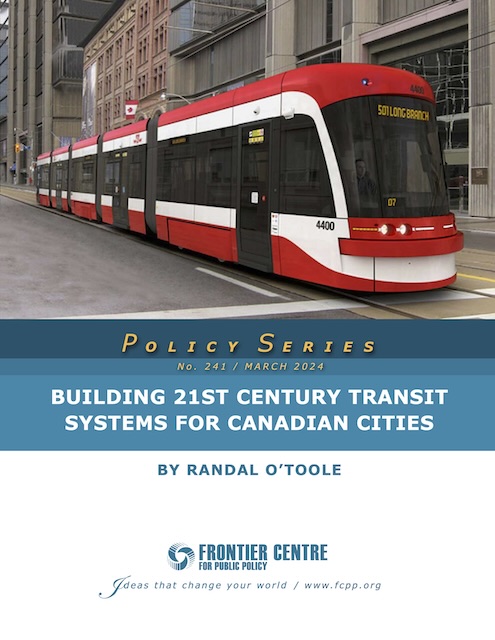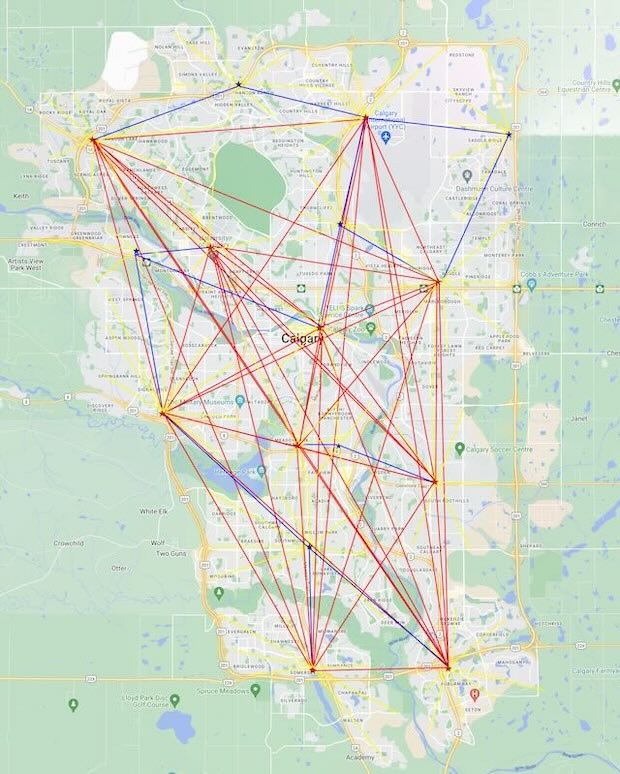As in the U.S., many Canadian transit agencies are fixated on building 19th-century transit systems that make no sense today, says a new report from the Frontier Centre for Public Policy. Instead of focusing on downtowns, as these transit agencies are doing, the report urges cities to develop polycentric transit systems that serve other economic centers as well as they now serve downtowns.
 Click image to download a copy of this report.
Click image to download a copy of this report.
The report scrutinizes transit systems in eight urban areas that have built or are planning to build rail transit lines. After adjusting for inflation, the costs of these lines has dramatically increased in recent years: Calgary light-rail construction costs quintupled from $53 million to $275 million per kilometer; Toronto subway costs have grown from $76 million to more than $1 billion per kilometer; and Edmonton, Vancouver, and other cities have seen similar increases.
Transit agencies have combined archaic transit technologies with an archaic view of cities. Nearly all of these rail systems center on downtowns, yet most people in Canadian urban areas no longer work downtown. In Calgary, for example, less than 15 percent of Calgary employees worked downtown before the pandemic (and probably even fewer since the pandemic). While about 45 percent of those downtown workers took transit to work, less than 10 percent of workers in the rest of the region commuted by transit, showing that transit was doing a poor job of serving the 85 percent of people who weren’t trying to get to or from downtown.
 Click image for a larger view.
Click image for a larger view.
The report was written by the Antiplanner, so of course it comes with a map of a proposed polycentric bus system, this one for Calgary. The above map shows ten primary transit centers (red stars) connected by non-stop buses to every other primary center (red lines); six secondary centers (blue stars) connected by non-stop buses to two or three other centers (blue lines); and about a dozen local buses radiating away from every primary and secondary center (yellow lines). That’s a total of 242 bus routes, which is 26 fewer than the number of bus routes currently operated by Calgary Transit.
This is the eighth major report I’ve written in the last 18 months. You can find and download all of them at the Thoreau Institute link above. I have finished another report that should be published soon.








Hopefully the good people of Canada will have the sense to realize that this is a cynical attempt to not build any public transit at all. If a city proposes a light rail, AP will say “buses are better because no one goes downtown”. If they then instead propose to build out the bus network, AP will switch to “99.9999999% of people have access to a car, so there’s no need for buses actually”
As long as they piss money for downtown workers.
YOU’RE TALKING about downtowns, where healthcare, finance, banking, Govt, catering services and IT are primary employees…Average salary is in 75,000 plus range. the LAST people on earth who need subsidized transit services.
Failure in logic here is that these small and moderate size cities want transportation infrastructure on par with their big city cousins. They don’t HAVE THE POPULATION and thus the tax base to afford billion dollar projects. So they expand their “vision” to the suburban outskirts. Towns and small cities do not need heavy rail or dedicated bus lanes. What is a “BIG” or “Small” city.
Manhattan has 1.6 million people, Toronto has 2.4 million but in area size of ALL five buroughs.
Contrary to popular belief, neither population or population densities dictate transit success, JOB CONCENTRATIONS do. Some cities like South American and Asian Megacities with 10 million plus people; Transit use makes sense, only in context of urban designs there’s no way you can move ten million people or even 1 million workers and commuters on a road system.
NYC is the largest job concentration in Downtown with 2 million jobs, 2nd Chicago with less than 1/3 that and in 3rd place is DC with barely a quarter.
Toronto has a downtown with 670,000 jobs. A sizeable down town to be sure, representing 44% cities jobs. Again….mostly in occupation sectors with relatively high incomes, which doesn’t justify multi-billion dollar rail systems, with exception perhaps of One line, served in east-west directions by buses. Instead of Hub and spoke models, Cities should implement a Pine tree model.
Where central branch is a North-south line of transit and Branches consisting of east-west bus routes running in circles.
Of course, more practical application, transit deregulation and private operators.
Janehavisham,
Who is really being cynical here? The person who thinks it is a waste to spend a billion dollars a mile on rail transit lines that could just as well be served by buses? Or the person who thinks that anyone who doesn’t believe in rail no matter how expensive must be somehow corrupt or cynical?
At it’s peak (Before government cronyism shut it down)
Ford owned “Chariot” was carrying 7,000 people a day, in it’s fleet of 100 vans across the San Francisco bay area. While 100 vans may seem traffic intensive, it’s better than 7000 cars on the road. With 18,000 people per square mile, SF is no small city. 1,000 vans could have handled HALF of BART’s passenger loads for fraction cost.
1,000 drivers, compared to 3,500 people who work for BART.
“spend a billion dollars a mile on rail transit lines that could just as well be served by buses?”
Why spend money on buses, when the money could just as well be spent on buying poor people a car?